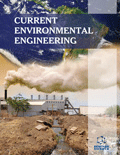[1]
Doumett S, Lamperi L, Checchini L, et al. Heavy metal distribution between contaminated soil and Paulownia tomentosa, in a pilot-scale assisted phytoremediation study: Influence of different complexing agents. Chemosphere 2008; 72(10): 1481-90.
[2]
Nouri J, Mahvi AH, Babaei A, Ahmadpour E. Regional pattern distribution of groundwater fluoride in the Shush aquifer of Khuzestan County Iran. Fluoride 2006; 39(4): 321-5.
[3]
McBride MB. Environmental chemistry of soils. New York: Oxford University Press 1994; pp. 567-9.
[4]
Dragun J. The soil chemistry of hazardous materials. The Hazardous Materials Control Research Institute Maryland 1988; pp. 355-61.
[5]
Gleyzes C. Fractionation studies of trace elements in contaminated soils and sediments: A review of sequential extraction procedures. Trends Analyt Chem 2002; 21: 451-67.
[6]
Binning K, Baird D. Survey of heavy metals in the sediments of the Swatkops River estuary, Port Elizerbeth South Africa. Water SA 2001; 24: 461-6.
[7]
Chukwujindu MA, Godwin EN, Francis OA. Assessment of contamination by heavy metals in sediment of Ase-River, Niger Delta, Nigeria. Res J Environ Sci 2007; 1: 220-8.
[8]
Magalhaes C, Coasta J, Teixeira C, Bordalo AA. Impact of trace metals on denitrification in estuarine sediments of the Douro River estuary, Portugal. Mar Chem 2007; 107: 332-41.
[9]
Eja CE, Ogri OR, Arikpo GE. Bioconcentration of heavy metala in surface sediments from the Great Kwa river estuary, Calabar, Southeast Nigeria. J Nig Environ Soc 2003; 1: 47-56.
[10]
Rauret G, López-Sanchez JF, Sahuquillo A, Barahona E, Lachica M, Ure AM. Application of a modified BCR sequential extraction (three-step) procedure for the determination of extractable trace metal contents in a sewage sludge amended soil reference material (CRM483), complemented by a three-year study of acetic acid and EDTA extractable metal content. J Environ Monit 2000; 2: 228-33.
[11]
Ebdon L, Evans EH, Fisher AS, Hill AS. An Introduction to Analytical Atomic Spectrometry. University of Plymouth, UK. 1998; Chap 1, p 6. ISBN 0 471 97417 X.
[12]
Li J, Xie ZM, Xu JM, Sun YF. Risk assessment for safety of soils and vegetables around a lead/zinc mine. Environ Geochem Health 2006; 28: 37-44.
[13]
MWH Americas, Inc. Balley, Henry and Enoch valley mines Remedial Investigation Background levels Development Technical Memorandum. 2013; pp. 450-5.
[14]
Muller G. The heavy metal pollution of the sediments of Neckars and its tributary. A stocktaking. Chem Zenith 1981; 105: 157-64.
[15]
Vitosh ML, Johnson JW, Mengel B. Tri-State fertilizer recommendation for corn, soybean and wheat. Extension Bulletin E New York 1995; pp. 252-80.
[16]
World Health Organization. Standard maxima for metals in
Agricultural soils. 1993.
[17]
World Health Organization (WHO). World Health Organization
guidelines for drinking water quality. 2nd edition,
Vol. 2, Health Criteria and Supporting Information, WHO
Geneva. 1996.
[18]
Jordao CP, Nascentes CC, Cecon PR, Fontes RLF, Pereira JL. Heavy metal availability in soil amended with composted urban solid wastes. Environ Monit Assess 2006; 112: 309-26.
[19]
Sobha K, Poornima A, Harini P, Veeraiah KA. Study on
biochemical changes in the fresh water fish, catla catla (hamilton)
exposed to the heavy metal toxicant cadmium chloride.
Kathmandu Univ J Sci Eng Technol 2007; (4): 1-11.
[20]
Nessner KV, Esposito E. Biotechnological strategies applied to the decontamination of soils polluted with heavy metals. Biotechnol Adv 2010; 28: 61-9.
[21]
Prasad MNV, Freitas H. Metal hyperaccumulation in plants Biodiversity prospecting for phytoremediation technology. Electron J Biotechnol 2003; 6: 275-321.
[22]
Kabata-Pendias A, Pendias H. Trace elements in soils and plant. 3rd ed. Boca Raton, Florida, USA: CRC Press 2002; p. 55.
[23]
Hanay O, Hasar H, Kocer NN, Aslan S. Evaluation for agricultural usage with speciation of heavy metals in a municipal sewage sludge. Bull Environ Contam Toxicol 2008; 81: 42-6.
[24]
Adewuyi GO, Osobamiro MT. Chemical speciation and potential mobility of some toxic metals in tropical agricultural soil. Res J Environ Toxicol 2016; 10: 159-65.
[25]
Abollino O, Giacomino A, Malandrino M, Menthasi E, Aceto M, Barberis R. Assessment of metal availability in contaminated soil by sequential extraction. Water Air Soil Pollut 2006; 13: 315-38.
[26]
Egiarte G, Corti G, Pinto M, et al. Fractionation of Cu, Pb, Cr, and Zn in a soil column amended with an anaerobic municipal sewage sludge. Water Air Soil Pollut 2009; 198: 133-48.
[27]
Rosazlin A, Che Fauziah I, Rosenani AB, Zauyah S. Domestic sewage sludge application to an acid tropical soil. Malays J Soil Sci 2007; 11: 81-95.
[28]
Manahan SE. Toxicological chemistry and biochemistry. 3rd edition. Florida: CRC Press 2003; pp. 12-4.
[29]
Akan JC, Mohammed TA, Zaynab MC, Fanna IA. Assessment of pollutants in water and sediment samples in Lake Chad, Baga, North Eastern Nigeria. J Environ Protect 2012; 3: 1428-41.
 10
10 2
2


